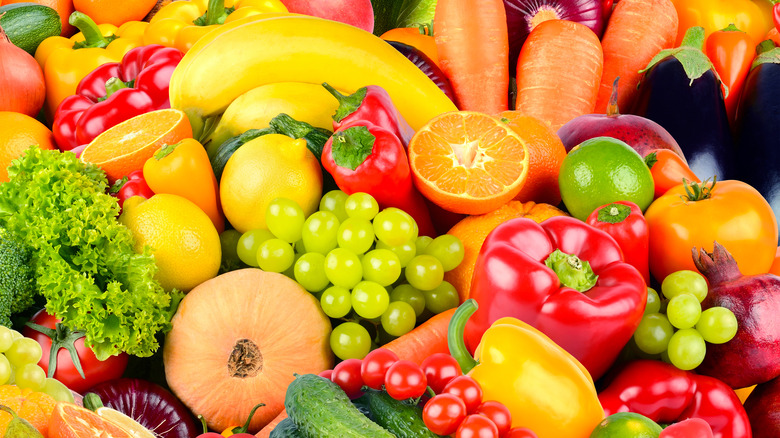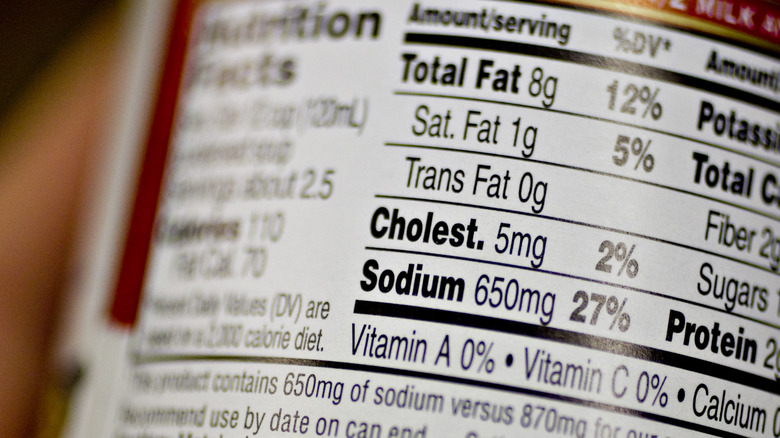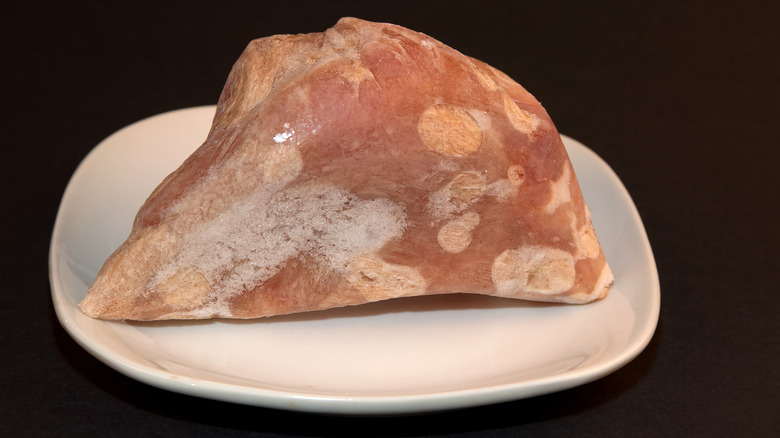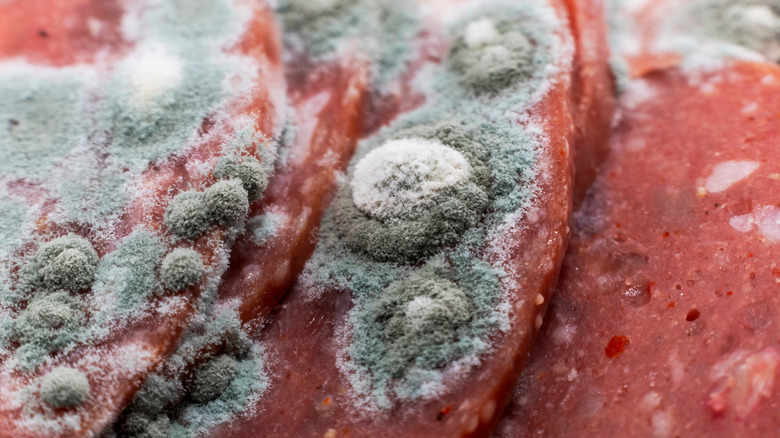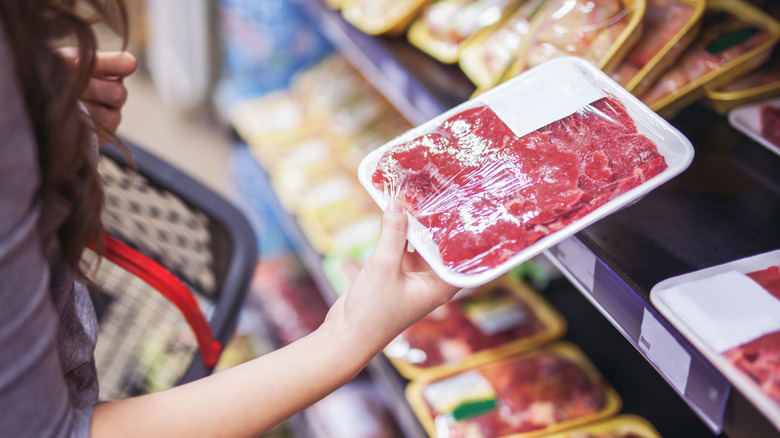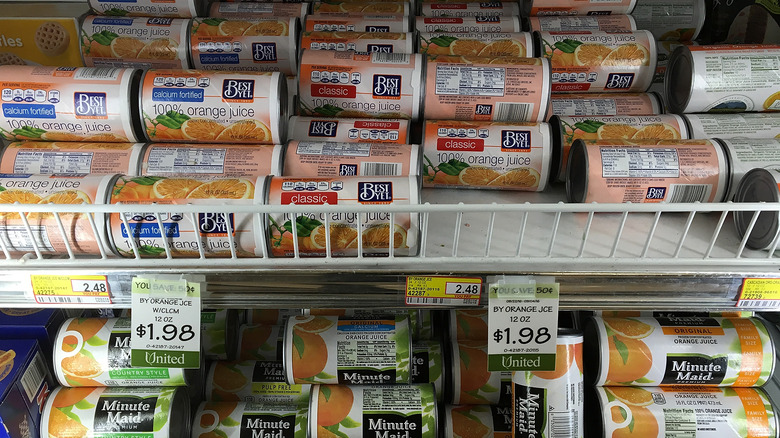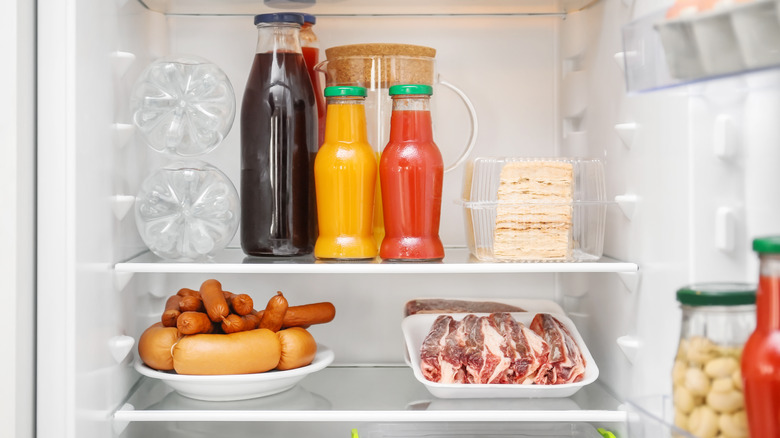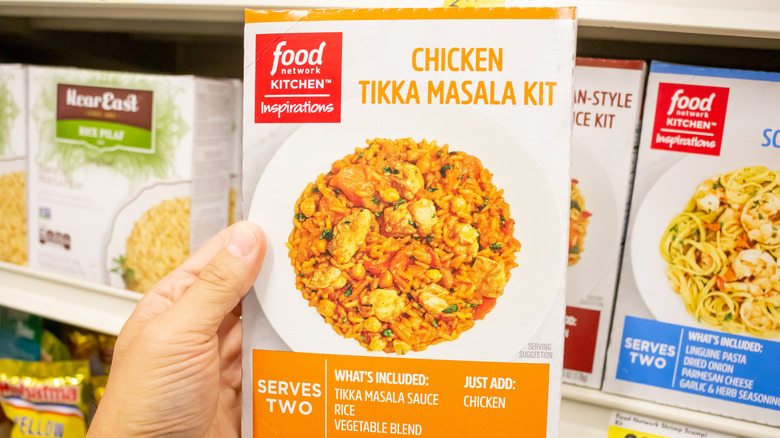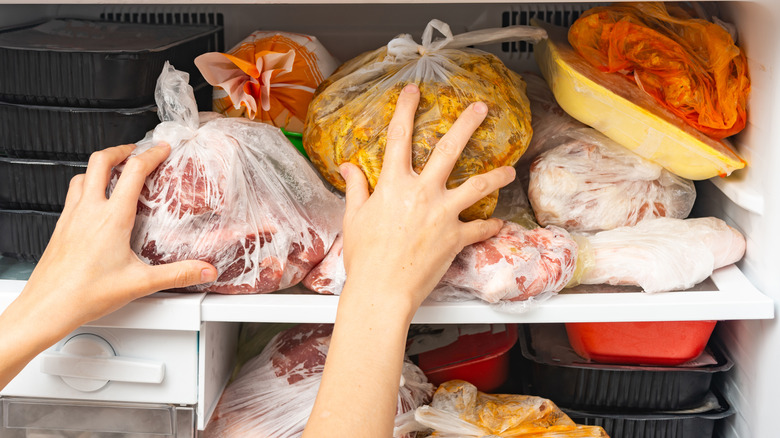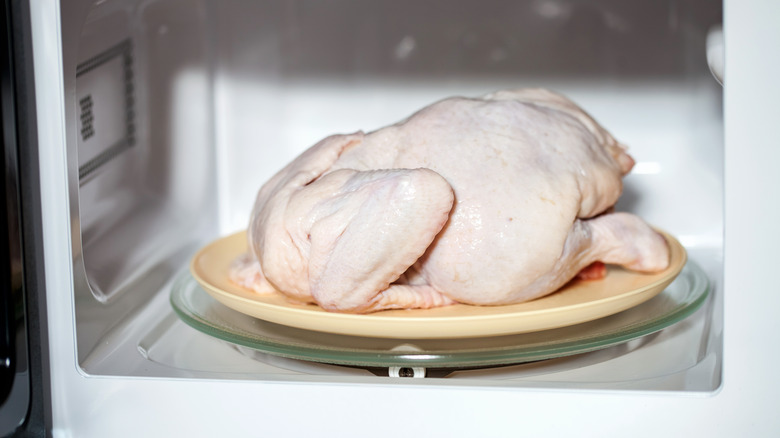Myths You Should Stop Believing About Frozen Foods
Do you steer clear of the freezer aisle of the grocery store, assuming everything you'll find there is less nutritious and tasty than food in the rest of the store, not to mention packed with fat, sodium, preservatives, and calories, plus more expensive to boot? It may be time to reevaluate those frozen food myths and give that chilly aisle a second chance. You might be surprised to discover that nutritious, tasty, and affordable options abound there.
Besides, if you care about staying up on the latest and greatest trends, the soaring popularity of frozen foods — spurred in part by restaurant shutdowns and fresh food shortages during the pandemic — is one you won't want to miss. According to Quartz, the increase in frozen food sales between January 2020 and January 2022 was a whopping 26%, and younger consumers are front and center on the shift. Quartz quotes a 2021 Deloitte survey that found consumers between the ages of 18 and 34 believe frozen meat is just as good as fresh, while only 39% of consumers 55 and older are onboard with that belief. Maybe reexamining some myths will help you join the frozen food fan club.
Myth: Fresh fruits and vegetables are more nutritious than their frozen counterparts
It seems logical that fresh fruits and vegetables would always be more nutritious than their frozen counterparts, but that's not necessarily the case. Fresh produce in your grocery store has spent days traveling to you, losing some of its freshness and nutrients along the way (via Cleveland Clinic). Fruits and vegetables in the freezer section were frozen immediately after harvesting, and therefore can actually be more nutritious. Indeed, a two-year study published in the Journal of Food Composition and Analysis compared nutrients in fresh, frozen, and fresh-stored (meaning the storage conditions in consumers' refrigerators) produce. Whether fresh produce is in the store or in your fridge, its nutrients — which dwindle over time — may not measure up to frozen varieties, according to study findings. And the Tufts Health & Nutrition Letter discusses two studies sponsored by the British Frozen Food Federation, which found that two-thirds of the frozen fruits and vegetables they tested had higher levels of vitamin C and other nutrients than fresh produce stored in a refrigerator.
There is one exception to frozen produce being fresher than fresh, according to the Cleveland Clinic: Local produce purchased at your neighborhood farmers market is most likely the freshest and most nutritious of all choices. The reason is that it was probably picked that very morning and delivered almost directly into your waiting arms.
Myth: Frozen meals are high in fat, sodium, preservatives, and calories
It's true that many frozen meals contain more sodium, fat, and preservatives than you want to consume, but it's also true that the healthfulness of the meals in the freezer section has come a long way in recent years (via Consumer Reports), and reading nutrition labels can help you sleuth out the healthy and tasty gems (via Insider). Mercy Health recommends choosing meals that contain lean proteins, whole grains, veggies, fruit, and fiber. Skip meals with fatty sauces and added sugar, and also those that have ingredients you can't pronounce.
Maybe the most important thing to check on the nutrition label of both frozen and non-frozen packaged foods is the number of servings in the container. Servings sizes were adjusted in early 2022 to better reflect the amount of the food one person typically eats, according to the U.S. Food & Drug Administration, but the package may still contain what's considered to be two or more servings. If you're going to eat the whole container yourself, you need to multiply all the nutritional calculations by the number of servings. Suddenly the product may not seem quite as healthy and appealing.
Myth: Frozen meat is safe to eat indefinitely
Yes, frozen meat is safe to eat indefinitely. But delicious to eat years into the future? Not so much. Chef Jennifer Stack, an instructor of nutrition and food safety at Culinary Institute of America, tells Today that long-frozen meats are still safe to eat if they've stayed frozen solid the whole time. That said, "they might not taste very good or (may) have a strange texture that makes them unappealing," she adds. She offers these guidelines: Fresh whole roasts and chickens maintain their quality for about a year. Cut meats are okay for four to six months, and meats like sausage lose quality after a couple months.
Recommended food storage lengths are based on keeping your freezer at zero degrees Fahrenheit, according to Prevention, and storage times decrease for every five-degree increase in temperature. Also, nothing should stay in your freezer for longer than a week if you're relying on a small freezer compartment in your fridge. If a freezer doesn't have its own exterior door, it's unable to consistently maintain zero degrees Fahrenheit. For more comprehensive information, the Food and Drug Administration (FDA) provides a chart of storage lengths for various kinds of foods in both refrigerators and freezers.
Myth: Freezing food kills bacteria
Freezing food at zero degrees Fahrenheit does kill some bacteria, but most of those bad boys just go into hibernation (via DailyHomeSafety). They bide their time until the food is defrosted, then spring back to life and start multiplying again. If you don't cook the food thoroughly, foodborne illness may be in your future.
While zero degrees Fahrenheit simply inactivates bacteria found in food, freezing food to sub-zero temperatures can kill bacteria, including trichina — a kind of worm, says the USDA. Conditions have to be just right to kill off trichina, however, and home freezers aren't up to the task. As the saying goes, "don't try this at home."
Basically, says EatingWell, if your food was bacteria-ridden when you stuck it in the freezer, it's going to come out that way when you defrost it. The only sure way to decimate bacteria is to cook the food to the recommended internal temperature before eating it.
Myth: Meat can be frozen in just the grocery store's packaging
It's okay to freeze meat in its original packaging if you're going to be using it within a month or two, says the U.S. Department of Agriculture (USDA). However, the store's packaging isn't airtight, so the meat will be prone to freezer burn quicker than if it had another layer of protection around it. Just wrapping the original package with an airtight layer of heavy-duty foil or freezer wrap will go a long way toward extending its quality in the freezer.
Is the meat still safe if the package somehow gets torn or unwrapped in the freezer? The USDA says thumbs-up on its safety; as long as the meat has been kept at zero degrees Fahrenheit, it's fine to eat. StillTasty agrees on the safety of the meat, but suggests that the meat's texture and taste may have suffered while it was exposed to the air. Check the meat for discoloration and areas that look like they've dried out, and either cut away the damaged areas and cook the meat right away, or replace the packaging and refreeze the meat.
Myth: Once you thaw frozen food it's unsafe to refreeze it
It's safe to refreeze foods that have been partially or completely thawed, as long as they were thawed in the fridge and kept at 40 degrees Fahrenheit or below for no more than three to four days, according to the University of Minnesota Extension. If completely thawed foods have been kept at room temperature for more than two hours, safety becomes questionable, so toss them. One notable example that you might not think of immediately is defrosted juice concentrates (via StateFoodSafety); they actually ferment and become contaminated with bacteria and toxins if left on the counter. Ugh!
Most foods don't become unsafe when thawed and refrozen, but they do lose some flavor and texture in the process. Ice cream is a prime example: It will never be the same once it's thawed and refrozen. Mayonnaise can also become less tasty. Additionally, meats that are thawed and refrozen lose moisture during the thawing process, which can affect their quality but not their safety (via University of Nebraska-Lincoln). Safety, they say, depends on safe handling every step of the way, from initial freezing through thawing and refreezing, or cooking and refreezing.
Myth: Frozen food is more expensive than fresh
It's hard to say whether frozen foods are more expensive than fresh foods because there are several variables to consider. Imagine buying a head of fresh broccoli and a box of fresh blueberries at the grocery store, along with bags of frozen broccoli and blueberries. Maybe — though possibly not — the fresh produce is initially cheaper, but you have to consider the possible waste that you're buying into with the fresh options, says The Penny Hoarder. The fresh broccoli may last a couple weeks in your fridge before it gets kind of slimy, and the blueberries? They'll probably be shriveled and moldy in less than a week. Their frozen counterparts, on the other hand, can last months in your freezer, ready to be pulled out whenever you need them.
Think about those evenings when you're tired and hungry, haven't had time to get to the grocery store, and don't have anything in the house to cook. Pulling frozen meat, vegetables, and fruit out of a well-stocked freezer and eating at home can save you big bucks compared with going to a restaurant or getting takeout or home delivery (via Money Under 30). A meal you prepare at home could cost as little as $4 for the groceries, while a restaurant meal might be $13 and up. And that's not even considering any extra meals you get from leftovers of the original home-cooked meal.
Myth: Frozen meat can be thawed on the counter
You should never thaw meat on the counter, or in hot water. Those thawing methods are putting you at risk of foodborne illness, according to the USDA. Instead, thaw meats in the fridge, in a bath of cold water, or in the microwave. If thawing in cold water, be sure the package is watertight. If it's not, the meat could be contaminated by bacteria in the water, and also become waterlogged. And change the water every 30 minutes to make sure it's always cold (via University of Illinois Extension). Foods thawed in cold water or the microwave should be cooked right away.
The trick to safe thawing is to plan ahead so you aren't rushing to defrost the meat at the last minute. A pound of ground meat of boneless chicken breasts usually takes up to 24 hours to defrost in the fridge. A whole turkey? Allow at least 24 hours for every 5 pounds of weight (via USDA). Defrosting takes even longer if your fridge is set at a temperature below 40 degrees Fahrenheit, or if the meat is placed in a part of your fridge that is colder than the rest of the space. It's also safe to cook meat and vegetables while they're still frozen; just plan on it taking 50% more time to cook than defrosted foods.
Myth: Frozen meals don't taste good
If your belief that frozen foods don't taste good is based on the frozen meals of yesteryear, or the outdated impression that frozen meals are just for weight loss, it's time to haul your opinion into the 21st century. Diverse products, healthier ingredients, and improved combinations of spices and seasonings have made frozen meals a tasty go-to, according to Today's Dietician. Offerings now represent regions that include the Middle East, Asia, and the Mediterranean. Indeed, as one example, Nestle's culinary development team even works with a global spice consultant to incorporate spices from around the world into its meals. Frozen food companies are even involving famous chefs to help hone their recipes, according to The New York Times.
As John McMillin, food industry analyst at Prudential Securities in New York tells The Times: "At the end of the day, people don't like to cook, and frozen food manufacturers have finally come out with better-tasting products that are competitive with restaurants and takeout."
Myth: All foods can be frozen
While it's true that all foods can be frozen, some foods lose taste, texture, and overall quality when frozen. According to the National Center for Home Food Preservation, foods that don't freeze well include raw salad ingredients such as lettuce, radishes, cucumbers, cabbage, and celery; they become limp, waterlogged, and lose their flavor. Foods made with egg whites can get soft, tough, rubbery, or weepy when frozen. Cooked macaroni, spaghetti, or rice, frozen by themselves, will get mushy and unappetizing. Spices and seasonings may also go through unappetizing transformations when frozen.
You can count on any food with a high water content to change texture when frozen (via Real Simple). Frozen grapes are great if you eat them frozen, but let them defrost and you'll have a soggy mess. Real Simple also adds hard-boiled eggs, soft cheeses, and raw potatoes to the list of foods that are best left unfrozen. And let's not forget whole-bean or ground coffee: Coffee aficionados say freezing introduces moisture into the coffee (via HuffPost), along with temperature fluctuations when you open and close your freezer door. Both are apparently detrimental to the coffee's optimal aroma and taste.
Myth: It doesn't matter where you store foods in your freezer
Frozen food can go anywhere in your freezer, right? Au contraire, says What's Cooking America. You should pay particular attention to how you store meat. Meats can contaminate other foods and areas of your freezer if they're stored helter-skelter. What's more, if they get lost or forgotten in the back or bottom of your freezer for months or even years, they won't be nearly as appealing and tasty when you get around to excavating them. They will probably be safe to eat, but you may not want to.
What's Cooking America recommends reserving a specific area of your freezer for meats, to avoid cross contamination between frozen foods. She also says it's best to wipe packages of meat with soapy water, add an extra layer of freezer paper or foil, and write the contents and date on the packages before freezing them. Also, add newly purchased foods to the bottom or back of your freezer and move the older ones up or forward, so you're using the older food first. "Your frozen foods will keep their quality longer if they are kept in the coldest part of the freezer, such as the bottom or back of the freezer," chef Jennifer Stack, nutrition and food safety instructor at the Culinary Institute of America, told Today. "The side door storage areas usually get a little warmer, so the food might soften or start to defrost."
Myth: Ice crystals are a sign that frozen food is unsafe to eat
Foods that are coated in ice crystals, known as freezer burn, are usually still safe to eat, says WebMD. But use common sense here: If you notice the food has a foul smell or other signs that it's spoiled, lob it right into the trash can.
Freezer burn occurs when frozen foods lose moisture while frozen for a long time, or when they've been partially defrosted. That doesn't make the food unsafe, but it may affect the appearance, texture, and taste of the foods. Meat, for example, may appear discolored, grainy, or dry, and have less-than-optimal flavor when eaten. Fruits and vegetables will dry out and flatten out, and ice cream will never be quite the creamy, delectable treat it once was.
You can minimize freezer burn by storing foods in airtight and watertight packages — not plastic bags — before sticking them in the freezer. When buying frozen fruits and vegetables, give the package a gentle squeeze to test its freshness, says MedicineNet. You should feel individual pieces of the food rather than a solid block of ice.
Myth: You should cook or refreeze meat right away after defrosting
Whether meat should be either cooked or refrozen asap after defrosting depends on how you thaw it. If you thaw it in the fridge, you don't have to cook it immediately, but you shouldn't wait too long, says the USDA. If you thaw it in cold water or the microwave, you should thoroughly cook it once it's fully defrosted, and always cook it before refreezing.
The kind of meat it is, as well as its cut, are important considerations when determining safety (via USDA). Raw ground meats, "variety meats" such as tongue and liver, seafood, and poultry can be safely refrigerated for just one to two days after unfreezing. Steaks, chops, and roasts — whether they're beef, pork, or lamb — are safe to refrigerate for three to five days before cooking. Also, after cooking any type of meat it's safe to refrigerate it for an additional three or four days.
All these recommendations are based on consistently keeping your fridge at the recommended 40 degrees Fahrenheit, says Healthline. Even at that temperature, bacteria can still grow and foods can become unsafe, so be sure to toss any foods that you know have been languishing in there too long.
Myth: You should throw out everything in your freezer if your power goes out
The food in a full freezer will usually be safe for about 48 hours during a power outage if the freezer temperature starts at zero degrees Fahrenheit and you keep the freezer door closed as much as possible during the outage. A freezer that is half full can usually keep food safe for 24 hours, says the FDA. If the power outage lasts longer than that, thawed or partially thawed foods can be safely refrozen or cooked if they weren't above 40 degrees Fahrenheit for more than two hours. Just be sure to completely cook the food to the recommended internal temperature (via StateFoodSafety).
FoodSafety.gov has a great chart for helping you decide whether to refreeze or toss foods after a power outage, and decisions depend on what kind of food it is and how long it was at temperatures above 40 degrees Fahrenheit. Never taste food to find out if it's safe — hopefully a no-brainer. And don't depend on how the food smells or looks to judge its safety, although visible ice crystals and feeling cold to the touch are pretty reliable signs that the food is still safe.
By the way, if you don't keep an accurate thermometer in your freezer already, getting one is a good way to prepare for a power outage (via FDA).


